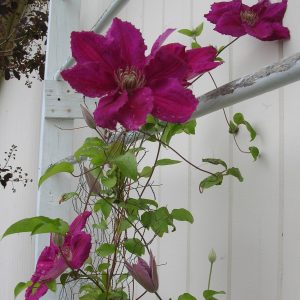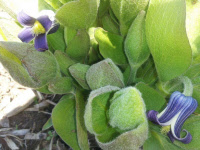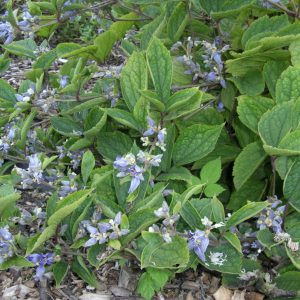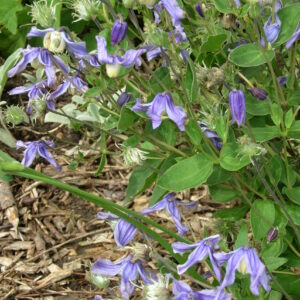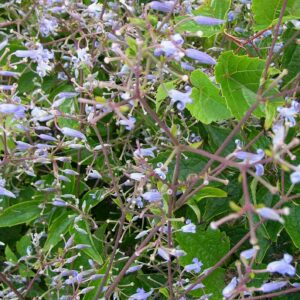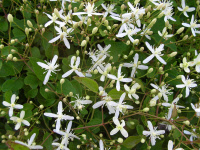Our Plants
Showing 137–144 of 587 results
-
Clematis ‘Ernest Markham’ Z 4-10
Big, bright magenta blooms June & repeat August – September, vigorous.
OUT OF STOCK
Big, bright magenta blooms June & repeat August – September, vigorous.
Size: 10-12’ x 2-3'
Care: Sun to part shade. Blooms on both old & new stems so cut back in early spring above healthy, big buds about 1' above ground.
Awards: Rated good by Chicago Botanical Garden Clematis evaluation.Hybrid c. 1930 by Ernest Markham (1881-1937) of England, head gardener at Gravetye Manor, home of William Robinson, father of mixed perennial borders.
-
Clematis fremontii Fremont’s leatherflower Z 4-7
Purple to white nodding bells with petal tips flipped up on this short perennial – not a vine
OUT OF STOCK
Purple to white nodding bells with petal tips flipped up on this short perennial – not a vine
Size: 12-18” x 12”
Care: sun to part shade in moist to moist well-drained soil
Native: Missouri, Kansas & Nebraska1st collected by John C. Fremont (1813-1890) celebrated American explorer, instigator of the “Bear Revolt” that made California independent from Mexico. Governor, then senator of California, owner of California gold mine, abolitionist (“free soil” Republican), leader of soldiers who massacred Native Americans, 1st candidate for president on the Republican ticket and Civil War general fired by Lincoln for freeing the slaves of Missouri. After accumulating fabulous wealth (gold mine) and spending it all, he died in poverty in New York. I call him the most interesting American you never heard of.
-
Clematis heracleifolia in China 大叶铁线莲 da ye tie xian lian PERENNIAL SHRUB Z 3-8
Hyacinth look alike sky blue flowers in August and September. One of internationally known garden designer Piet Oudolf’s 100 “MUST HAVE” plants, Gardens Illustrated 94 (2013)
Hyacinth look alike sky blue flowers in August and September. One of internationally known garden designer Piet Oudolf’s 100 “MUST HAVE” plants, Gardens Illustrated 94 (2013)
Size: 30” x 3’
Care: sun in moist well-drained soil. Prune back to 6” above ground in spring
Native: hillsides in central China
Wildlife Value: attracts beesCollected by French missionary Armand David before 1841. ”A sub-shrubby kind from China, bearing large quantities of tubular blue flowers … “ H.H. Thomas 1915
-
Clematis integrifolia Z 3-7
Summer, real true blue and sometimes white, pendant flowers measuring 2" across on this short, non-vining Clematis
OUT OF STOCK
Summer, beautiful true blue and sometimes white, pendant flowers measuring 2” across on this short, non-vining Clematis
Size: 24" x 24"
Care: Sun to part shade in humusy, well-drained soil. Prune to near ground in early spring.
Native: Central EuropeThe genus Clematis was named by Dioscordes, physician in Nero’s army, from “klema” meaning climbing plant. Sixteenth century English herbalist John Gerard called Clematis “traveler’s joy” because of the joy given to travelers by the beauty of the flowers. This species collected in Hungary by 1573. English herbalist Gerard grew this plant by the late 1590’s.
-
Clematis occidentalis var. occidentalis Purple clematis. Short-styled bluebell Z 4-8
Four petaled (sepals), purple, down-facing, 4” long bells flowering in spring encircling a bundle of styles and stamens.
OUT OF STOCK – EMAIL FOR AVAILABILITY
Four petaled (sepals), purple, down-facing, 4” long bells flowering in spring encircling a bundle of styles and stamens.
Size: 3-12” x 2’
Care: sun to shade in moist well-drained to well-drained, alkaline soil
Native: Maine to Minnesota south to Illinois and South Carolina and all states between, Wisconsin native. Endangered in three states; “of special concern” in Wisconsin and gone in Ohio.The species first described by Danish botanist Jens Wilken Hornemann in 1805. var. occidentalis is the eastern variety of the species (peculiarly called occidentalis meaning west.) The species and other varieties are native in western US.
-
Clematis stans Japanese clematis Z 4-8
soulful blue starry nodding bells
OUT OF STOCK
Fragrant, smelling of sweet violets, soulful blue starry nodding bells with petals that flip up at the ends (recurved) Blooms August – September. Ships only in spring
Size: 30" x 24"
Care: sun to part shade in moist well-drained soil
Native: JapanStans means “upright” as this is a bush, rather than a vine. (OK, we’ve put this in the vine category and it’s not a vine. But most people think of Clematis as vines and we didn’t want you to miss it.) In Japan called “Kusa-botan.” Collected by Ernest Henry ‘Chinese’ Wilson before 1910.
-
Clematis tangutica Russian virgin bower Z 4-9
Small yellow flowers bloom for months
OUT OF STOCK
Small yellow flowers bloom for months, from July to September, then turn into ornamental spidery seed heads.
Size: 15-20’ x 6-10’
Care: Sun - part shade in moist well-drained to well-drained soil. Prune close to the ground in spring.
Native: NW China and TurkestanThe genus Clematis was named by Dioscordes, physician in Nero’s army, from klema meaning “climbing plant.” Sixteenth century English herbalist John Gerard called Clematis “traveler’s joy” because of the joy given to travelers by the beauty of the flowers. This species, C. tangutica introduced to western cultivation in 1898 when it was sent to Kew Gardens from St. Petersburg, Russia, after its discovery in Tibet.
**LISTED AS OUT OF STOCK BECAUSE WE DO NOT SHIP THIS ITEM. IT IS AVAILABLE FOR PURCHASE AT OUR RETAIL LOCATION.
-
Clematis ternifolia Sweet Autumn clematis Z 4-8
Fragrant, small white blossoms smother this vigorous vine
Fragrant, small white blossoms smother this vigorous vine in September and October.
Can not ship to: Alabama, Delaware, Florida, Georgia, Maryland, Nebraska, New York, North Carolina, South Carolina, Tennessee and Virginia.
Size: 15-20’ x 6-10’
Care: Sun moist well-drained soil mulched. Flowers on current year’s wood. Cut back in early spring to 6-8” above the soil.
Native: JapanThe genus Clematis was named by Dioscordes, physician in Nero’s army, from “klema” meaning climbing plant. In 1877 seeds of this vine sent from Russia to the Arnold Arboretum in Boston, then distributed to nurseries throughout America.

